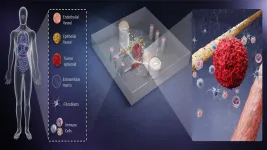Abnormal hyperactivation in the brain may be an early sign of Alzheimer's
2021-01-21
(Press-News.org) Abnormally hyperactive areas in the brain may help better predict the onset of Alzheimer's disease, according to findings of a research team led by Université de Montreal psychology professor Sylvie Belleville, scientific Director of the Institut universitaire de gériatrie de Montréal research centre.
Hyperactivation could be an early biomarker of Alzheimer's disease, the researchers say in their study published today in Alzheimer's & Dementia: Diagnosis, Assessment & Disease Monitoring, co-authored by Belleville and Nick Corriveau-Lecavalier, a doctoral student she supervises.
Worried about their memory
In their research, the team found hyperactivation in certain brain areas in people not yet diagnosed with Alzheimer's but who were worried about their memory and who exhibited risk factors for the disease.
The study marks an important milestone in this research area, as the hyperactivation of regions susceptible to the Alzheimer's as shown by functional magnetic resonance imaging (fMRI) was observed in people with no clinical symptoms and before the onset of cognitive impairments detected with standardized tests.
"This study indicates that abnormal activation in these areas may be observed many years before diagnosis," said Belleville.
This finding is crucial to the advancement of knowledge about the disease., she continued.
"Alzheimer's disease is progressive and may emerge in the brain 20 to 30 years before diagnosis. It is therefore very important to pinpoint biomarkers - that is, physical and detectable signs of the disease - and to better understand the initial effects on the brain. Hyperactivation could therefore represent one of the first signs of Alzheimer's disease."
An inverse U-shape
The team observed that, as the disease progresses, neuronal activation follows an inverse U-shape trajectory. Indeed, activation in certain areas of the brain in the early stages of Alzheimer's may significantly increase before the neuronal loss that is caused by the disease leads to a clear decrease in activation.
"This form may characterize the underlying pathological process and help doctors determine the stage of the disease," explained Corriveau-Lecavalier, the study's first author. "When combined with other indicators such as blood work and cognitive tests, this type of neuroimaging investigation could help with possible earlier detection."
For their study, the team used data from the Consortium for the Early Identification of Alzheimer's Disease to study brain activation in groups of individuals at a high risk of developing Alzheimer's disease who had performed a memory task while being scanned with fMRI. One group consisted of 28 individuals who were concerned about their memory but who did not show cognitive impairments on traditional clinical tests. The other group included 26 individuals with mild cognitive impairments.
The researchers found that the individuals in the first group, or those with memory complaints but who did not show objective cognitive impairments, had abnormally high levels of activation in multiple key regions of the brain affected by Alzheimer's disease. Individuals with mild cognitive impairments, who are considered to be at a more advanced stage of the disease, tended to show decreased activation in these brain regions.
INFORMATION:
About this study
"A quadratic function of activation in individuals at risk of Alzheimer's disease," by Nick Corriveau-Lecavalier et, was published Jan. 21, 2021 in Alzheimer's & Dementia: Diagnosis, Assessment & Disease Monitoring. Corriveau-Lecavalier was supported by a CIHR doctoral grant, Belleville by CIHR and other Canadian and Quebec public funders.
ELSE PRESS RELEASES FROM THIS DATE:
2021-01-21
A new study of Type 2 diabetes (T2D) in Japanese populations has uncovered a previously uncharacterized genetic variant that puts male carriers at greater risk for the disease, as well as the mechanism by which it does so. The impact of the variant was most pronounced in sedentary men; those with the variant had a 65% greater rate of T2D than sedentary men without it.
Researchers from the University of Southern California, along with colleagues in Japan, led by Professor Noriyuki Fuku of Juntendo University, found higher rates of harmful belly fat and T2D among Japanese men with a specific mitochondrial gene variant. This variant, in the site of the mitochondrial peptide ...
2021-01-21
Researchers from LSTM's Centre for Snakebite Research and Interventions (CSRI) have led an international team investigating the evolutionary origins of a novel defensive trait by snakes - venom spitting - and demonstrated that defensive selection pressures can influence venom composition in snakes in a repeatable manner.
In a paper published in the journal Science, the team, which includes authors from the UK, USA, Australia, the Netherlands, Spain, Norway, Brazil and Costa Rica, provide the first example of snake venom evolution being demonstrated to be associated with a role in defence, ...
2021-01-21
Scientists have created a highly detailed map of skin, which reveals that cellular processes from development are re-activated in cells from patients with inflammatory skin disease. The researchers from the Wellcome Sanger Institute, Newcastle University and Kings College London, discovered that skin from eczema and psoriasis patients share many of the same molecular pathways as developing skin cells. This offers potential new drug targets for treating these painful skin diseases.
Published on 22nd January in Science, the study also provides a completely new understanding of inflammatory disease, opening up new avenues for research on other inflammatory diseases such as rheumatoid arthritis and inflammatory bowel disease.
Part of the global ...
2021-01-21
ITHACA, N.Y. - A streamlined process for awarding green cards to international STEM doctoral students graduating from U.S. universities could benefit American innovation and competitiveness, including leveling the field for startups eager to attract such highly skilled workers, according to a new study by researchers from Cornell University and the University of California, San Diego.
The new Biden administration backs policy reform aimed at achieving that end, which was part of bipartisan legislation proposed more than a decade ago. But progress has been stalled by broader concerns about visas ...
2021-01-21
LA JOLLA, CA--A big question on people's minds these days: how long does immunity to SARS-CoV-2 last following infection?
Now a research team from La Jolla Institute for Immunology (LJI), The University of Liverpool and the University of Southampton has uncovered an interesting clue. Their new study suggests that people with severe COVID-19 cases may be left with more of the protective "memory" T cells needed to fight reinfection.
"The data from this study suggest people with severe COVID-19 cases may have stronger long-term immunity," says study co-leader LJI Professor Pandurangan Vijayanand, M.D., Ph.D.
The research, published Jan. 21 in Science Immunology, is the first to describe the T cells that fight SARS-CoV-2 in "high resolution" ...
2021-01-21
Vaccinating people over 60 is the most effective way to mitigate mortality from COVID-19, a new age-based modeling study suggests. Although vaccination of younger adults is projected to avert the greatest incidence of disease, vaccinating older adults will most effectively reduce deaths, the analysis shows. Less than one year after SARS-CoV-2 was identified, deployment of multiple vaccines against the virus has been initiated in several countries. Although vaccine production is being rapidly scaled up, demand will exceed supply for the next several months. An urgent challenge is the optimization of vaccine allocation to maximize public health benefit. To quantify the impact of COVID-19 vaccine ...
2021-01-21
Vaccinating older adults for COVID-19 first will save substantially more U.S. lives than prioritizing other age groups, and the slower the vaccine rollout and more widespread the virus, the more critical it is to bring them to the front of the line.
That's one key takeaway from a new University of Colorado Boulder paper, published today in the journal Science, which uses mathematical modeling to make projections about how different distribution strategies would play out in countries around the globe.
The research has already informed policy recommendations by the Centers for Disease ...
2021-01-21
It is no secret that over the last few decades, humans have changed nature at an ever-increasing rate. A growing collection of research covers the many ways this is impacting our quality of life, from air quality to nutrition and income. To better understand how which areas are most at risk, scientists have combed through volumes of literature to present global trends in the relationship between human wellbeing and environmental degradation.
Their work, which included Fabrice DeClerck from the Alliance of Bioversity International and CIAT, was summarized in "Global trends in nature's contributions to people", which was recently published in Proceedings of the National Academy of Sciences.
This systematic ...
2021-01-21
WASHINGTON, January 21, 2021 -- Despite cancer being a leading cause of death worldwide, treatment options for many types of cancers remain limited. This is partly due to the in vitro tools used to model cancers, which cannot adequately predict the behavior of a cancer or its sensitivity to drugs.
Further, animal models, like mice, biologically differ from humans in ways that play a critical role in immunotherapy, and results from animal studies do not always translate well to human disease.
These shortcomings point to a clear need for a better, patient-specific model to improve the understanding of cancer cells and their impacts.
Researchers from the University of Wisconsin and the University ...
2021-01-21
Medicated drops may help close small macular holes over a two- to eight-week period, allowing some people to avoid surgery to fix the vision problem, a new study suggests.
The findings, based on a retrospective multicenter case series published Dec. 15, 2020, in Ophthalmology Retina, could lead to a better understanding of which patients may benefit from the treatment, as well as the timeline of the treatment's effectiveness.
"For certain patients, medicated drops may heal their macular hole by decreasing inflammation and increasing fluid absorption in the retina," said ophthalmologist and retinal surgeon Dimitra Skondra, MD, PhD, senior author of the study. Skondra is an associate professor of ophthalmology and visual ...
LAST 30 PRESS RELEASES:
[Press-News.org] Abnormal hyperactivation in the brain may be an early sign of Alzheimer's




